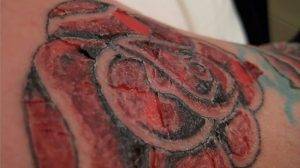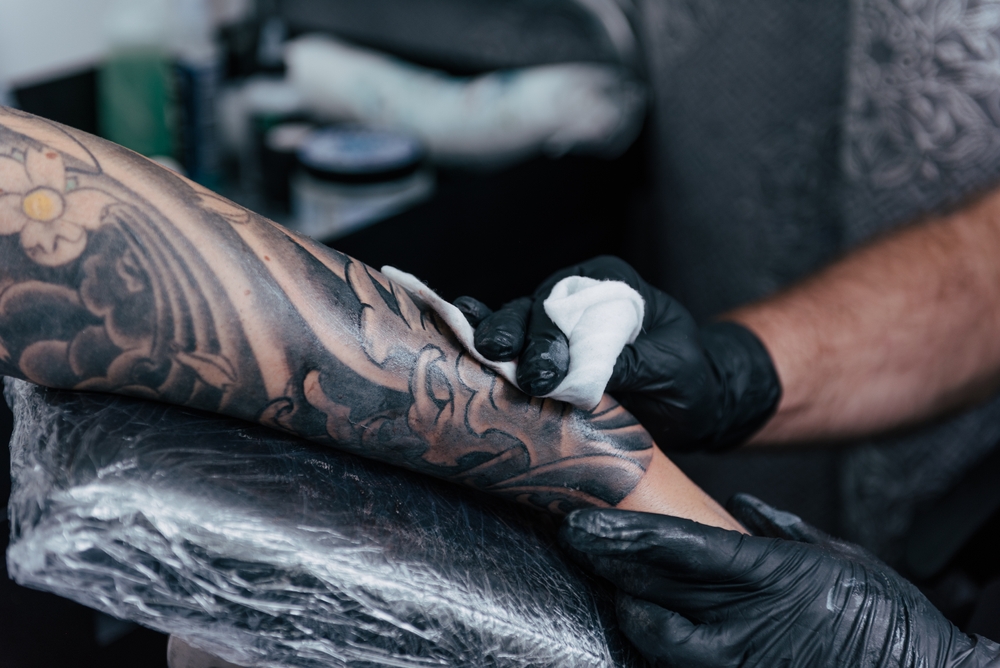Tattoo aftercare prevents infections and skin complications.
Just got a new tattoo? Be careful! Poor care after getting a tattoo can result in bacterial infections, contaminated ink, and even permanent skin damage. Following proper aftercare promotes smooth healing and preserves your tattoo’s appearance for as long as possible.
Here are four aftercare tips to ensure your new tattoo heals well.
1. Don’t Submerge Your Tattoo in Water
Submerging a new tattoo in water significantly increases the risk of bacterial and fungal infections. Fresh tattoos are open wounds, making them highly susceptible to contamination. One source points out that tattoo aftercare requires a strict approach to keeping the area clean and dry to prevent complications.
Water from swimming pools, hot tubs, lakes, and oceans often contains bacteria and chemicals that can easily enter the skin through the tattoo. In fact, the research highlights that bacterial infections can affect up to 5% of individuals with new tattoos, especially when proper aftercare is not followed.

Image credit: CNN
Tattoo causes sepsis in man after swimming
A tragic case reported by CNN illustrates the dangers: “Five days after getting his tattoo, the man decided to go for a swim in the Gulf of Mexico. Just three days after that, he was admitted to Parkland Memorial Hospital in Dallas with severe pain in both of his legs and feet.”
He was later diagnosed with a Vibrio vulnificus infection, which led to septic shock and, ultimately, his death.
Dr. Nicholas Hendren, an internal medicine resident, stresses the importance of avoiding prolonged exposure to potentially contaminated water while a tattoo heals.
“The No. 1 thing to avoid while a tattoo heals is soaking it. That means quick showers, no baths, and certainly no swimming.” he shared.
Keeping direct contact with water to a minimum and patting the area dry after cleaning helps avoid irritants and speeds healing.
2. Reduce Exposure to UV Radiation
Ultraviolet (UV) radiation poses a serious threat to the appearance and longevity of tattoos. Exposure to UV rays, especially in coloured tattoos, can cause premature fading, dryness, and scarring.
UV radiation breaks down tattoo ink particles through a process called photochemical cleavage.
“As the ink ages and gets absorbed, the different colour components start to show. Green (and sometimes blue) shades are the last to get absorbed. This issue is more evident with older or low-quality inks.” Tattoo artist Zara shared on her social media.
This not only causes the tattoo to fade unevenly but can also trigger immune responses that transport ink particles away from the tattooed area.
View this post on Instagram
A case report describes a man with significant fading in the areas of his tattoo exposed to the sun compared to those shielded from UV radiation. His tattoo, originally vibrant, began to lose colour within six years due to frequent outdoor activities without proper UV protection.
The sun-exposed parts of the tattoo showed dull, washed-out colours, especially in the red and yellow areas, which are particularly vulnerable to UV damage. His skin also displayed signs of sun damage, such as solar lentigos (sunspots) and xerosis (dry skin), which further compromised the appearance of his tattoo.
Dr. Robert Finney, a board-certified dermatologist in the U.S., emphasised the importance of protecting your tattoo from the sun during healing.
“Sun will cause tattoos to fade, especially if you get a lot of sun exposure early on, so make sure to keep it covered or apply SPF 30 or higher regularly,” he explained in an interview with Byrdie.
Regular sun protection not only helps preserve the vibrancy of the ink but also prevents skin damage, which can affect the healing process.
3. Prioritise Aftercare to Prevent Infection Risks
Bacterial infections are a significant risk after getting a tattoo, especially when aftercare is inadequate. One review found that tattoo-related infections can range from mild skin infections, like abscesses, to severe complications, including cellulitis, endocarditis, and even septic shock. Tattoo needles penetrate the dermis, creating an entry point for bacteria, which can lead to local or systemic infections.

Infected tattoo (Image credit: Removery)
A major cause of these infections is poor hygiene during the tattooing process or improper tattoo aftercare. Contaminated tattoo inks, unsterilised equipment, and poor hygiene in tattoo studios are common sources of bacteria. However, infections can also occur if clients neglect aftercare instructions.
To reduce the risk of bacterial infections, it’s important to follow proper tattoo aftercare steps:
- Clean the tattoo regularly with antibacterial soap and clean water.
- Keep your hands clean before touching the tattooed area.
- Apply a sterile moisturiser or ointment recommended by the tattoo artist.
- Avoid scratching or picking at the tattoo to prevent bacteria from entering the skin.
- Keep the tattoo dry, avoiding submersion in water (e.g., pools, hot tubs) until fully healed.
- Wear loose clothing to avoid irritation and rubbing on the tattooed area.
- Avoid unapproved products like non-sterile lotions or creams.
- Watch for signs of infection, such as increased redness, swelling, or discharge, and seek medical help if needed.
4. Avoid Picking at Your Tattoo
Allowing your tattoo to heal without interference is crucial for avoiding complications. Physical trauma to a healing tattoo, such as scratching or picking at scabs, can not only delay recovery but also cause long-term damage.
Studies highlight that improper care, like picking, can lead to issues such as infections, contact dermatitis, or even Koebnerisation — a reaction where trauma to the skin triggers further inflammation.
Ink fall out from picking at tattoo scabs (Image: Flickr)
Tattoo aftercare guidelines are designed to minimise these risks. Scabs that form are part of the body’s natural healing process, protecting the tattooed skin as it regenerates. Picking at scabs can damage this protective barrier, leaving the tattoo vulnerable to bacteria and delaying the healing process. In more severe cases, repeated picking can lead to scarring, which may distort the final appearance of the tattoo and affect the retention of ink.
To support the healing process, moisturising the area with a recommended ointment and keeping it clean helps alleviate itching and discomfort, reducing the temptation to scratch. It is also essential to wear loose clothing over the tattoo to prevent irritation from friction.
Tattoos Are for Life – But Their Longevity Depends on Tattoo Aftercare
A tattoo is more than just ink on skin – it’s a permanent piece of art. Like anything meaningful, it requires attention to last. Fading and wear are a normal part of life, just like the stories our skin tells over time. However, how well your tattoo ages depends largely on how much care you put into it.
“Ink is forever, but the outcome of your tattoo depends on the quality of your aftercare almost as much as it depends on the skill of your tattoo artist.” Dr. Alok Vij, a dermatologist, explained in an interview with the Cleveland Clinic.
From the moment you leave the tattoo studio, your aftercare routine determines whether your tattoo heals beautifully or faces complications. Proper aftercare ensures your new artwork remains a beautiful part of your skin for years to come.
Have a pressing question for a doctor? Medical Channel Asia has launched a community forum page where you can get questions answered by a medical specialist. Visit the community forum here.


